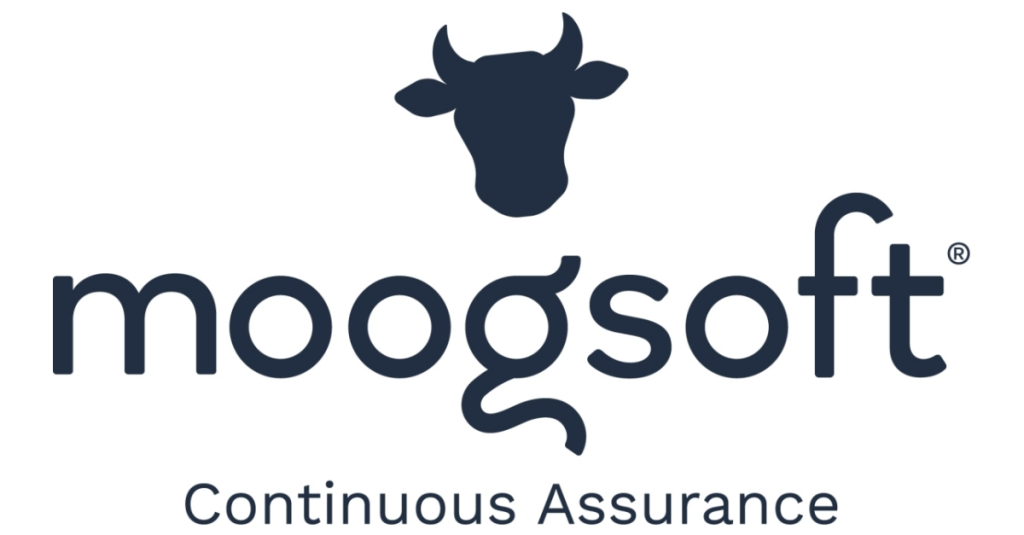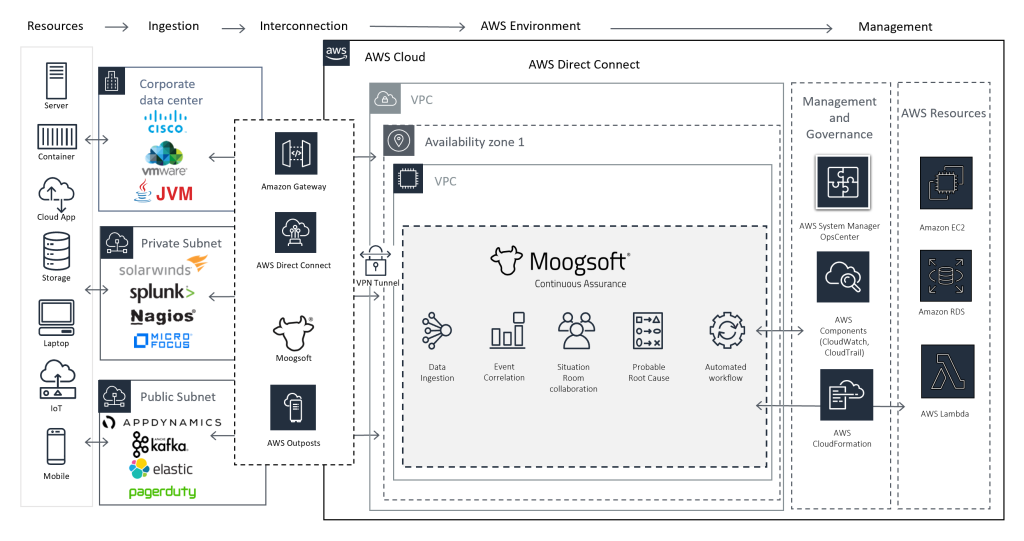What is Moogsoft ?

Moogsoft is an AI-powered observability platform designed to help IT teams proactively identify and resolve IT incidents. It leverages artificial intelligence and machine learning (AI/ML) to analyze large volumes of event data from various sources, reducing noise and pinpointing the root cause of issues faster. This translates to quicker resolution times, improved uptime, and a more efficient IT environment.
Top 10 use cases of Moogsoft?
Top 10 Use Cases of Moogsoft:
- Anomaly Detection & Alert Correlation: Moogsoft uses AI to identify unusual patterns in event data, automatically correlating seemingly unrelated alerts to pinpoint the root cause of incidents. This reduces the time spent sifting through irrelevant alerts and helps teams focus on critical issues.
- Root Cause Analysis (RCA): The platform uses advanced analytics and historical data to automatically pinpoint the root cause of incidents, saving valuable time and effort compared to manual RCA processes.
- Automated Remediation: Moogsoft offers predefined and custom remediation workflows that can automatically trigger actions like restarting services or rerouting traffic based on specific incident conditions, further accelerating resolution times.
- Predictive Maintenance: By analyzing trends and patterns in historical data, Moogsoft can predict potential incidents before they occur, enabling proactive measures to prevent downtime and ensure service continuity.
- Improved IT Collaboration: The platform provides a shared view of IT events and incidents, facilitating communication and collaboration among different teams involved in troubleshooting and resolution.
- Improved Mean Time to Resolution (MTTR): By automating tasks and providing faster root cause analysis, Moogsoft can significantly reduce the time it takes to resolve incidents, leading to improved uptime and user experience.
- Improved Mean Time to Detection (MTTD): The AI-powered anomaly detection allows for early identification of potential issues, minimizing the impact of incidents before they escalate.
- Improved IT Efficiency: By automating tasks and streamlining workflows, Moogsoft frees up IT teams to focus on strategic initiatives and innovation, increasing overall IT efficiency.
- Cost Reduction: Proactive incident resolution and prevention can lead to significant cost savings by reducing downtime, resource usage, and manual troubleshooting efforts.
- Enhanced Service Levels: Improved MTTR and MTTD ultimately translate to better service levels for end users, ensuring consistent performance and availability of IT services.
This is not an exhaustive list, and the specific use cases will vary depending on the individual needs and priorities of each organization. However, Moogsoft’s focus on AI-powered observability makes it a valuable tool for organizations seeking to optimize their IT operations and improve service delivery.
What are the feature of Moogsoft?
Moogsoft’s AIOps platform boasts a variety of features designed to help IT teams proactively manage and resolve incidents. Following are some of the key functionalities to highlight:
Early Detection and Anomaly Identification:
- AI-powered anomaly detection: Moogsoft leverages machine learning algorithms to analyze vast amounts of event data from diverse sources, identifying unusual patterns and deviations from normal behavior that could indicate potential issues.
- Advanced correlation: The platform correlates seemingly unrelated alerts from different systems and applications, automatically pinpointing the root cause of complex incidents and reducing alert fatigue.
- Predictive maintenance: By analyzing historical trends and patterns, Moogsoft can predict potential incidents before they occur, enabling proactive measures to prevent downtime and ensure service continuity.
Faster Incident Resolution:
- Automated root cause analysis (RCA): Moogsoft employs advanced analytics and historical data to automatically identify the root cause of incidents, saving valuable time and effort compared to manual RCA processes.
- Automated remediation: Predefined and custom remediation workflows can be triggered automatically based on specific incident conditions. This could involve restarting services, rerouting traffic, or notifying designated personnel for immediate action.
- Mean Time to Resolution (MTTR) improvement: By automating tasks and facilitating faster root cause analysis, Moogsoft can significantly reduce the time it takes to resolve incidents, leading to improved uptime and user experience.
Enhanced Collaboration and Efficiency:
- Single platform for real-time visibility: Moogsoft provides a shared view of IT events and incidents across various systems and teams, fostering collaboration and communication during troubleshooting and resolution.
- Improved IT efficiency: Automating tasks, streamlining workflows, and eliminating manual troubleshooting efforts frees up IT teams to focus on strategic initiatives and innovation.
- Mean Time to Detection (MTTD) improvement: Early identification of potential issues thanks to AI-powered anomaly detection minimizes the impact of incidents before they escalate, reducing MTTD.
Additional Features:
- Integration with diverse IT tools: Moogsoft integrates seamlessly with various monitoring and ticketing systems, centralizing data for comprehensive observability.
- Customizable dashboards and reports: Users can personalize dashboards and reports to gain insights tailored to their specific needs and roles.
- Open API for automation: The platform’s open API enables integration with custom scripts and tools for further automation and flexibility.
- Security and compliance: Moogsoft adheres to strict security standards and compliance regulations to ensure data privacy and protection.
It’s important to note that the specific features and functionalities may vary depending on the chosen Moogsoft edition and any additional modules or customizations implemented.
How Moogsoft works and Architecture?

Moogsoft’s AIOps platform works in a multi-layered approach to deliver efficient IT operations management. Here’s a breakdown of its key functionalities and architectural components:
Data Ingestion and Processing:
- Data Collection: Moogsoft ingests event data from various sources like monitoring systems, applications, infrastructure, and network devices. This data can be in various formats (e.g., logs, metrics, SNMP traps) and is collected through connectors or APIs.
- Data Deduplication and Normalization: The platform pre-processes the collected data by removing duplicates, normalizing formats, and enriching it with relevant context (e.g., timestamps, severity levels).
- AI-powered Anomaly Detection: Machine learning algorithms analyze the normalized data to identify deviations from normal behavior and potential anomalies that could indicate incidents.
- Alert Correlation and Grouping: Similar or related anomalies are grouped into “Situations,” reducing alert fatigue and focusing attention on the root cause.
Root Cause Analysis and Resolution:
- Advanced Analytics: Moogsoft applies advanced analytics techniques (e.g., time series analysis, root cause tree algorithms) to identify the root cause of Situations, correlating events across different systems and timeframes.
- Automated Remediation: Predefined or custom workflows can be triggered based on specific Situations, automatically taking actions like restarting services, rerouting traffic, or notifying personnel.
- Knowledge Base and Collaboration: The platform stores historical data and learnings in a knowledge base, improving future anomaly detection and facilitating collaboration between IT teams.
Architecture:
Moogsoft’s architecture can be viewed in two ways:
- Data Processing Modules: This refers to the functional modules handling various data processing tasks like ingestion, normalization, correlation, and analysis. Each module operates independently but interacts with others to ensure smooth data flow.
- Software Components: This focuses on the individual software components like databases, messaging queues, and application servers that make up the platform. These components work together to support the functionalities of the data processing modules.
Key Architectural Features:
- Scalability: The architecture is designed to handle large volumes of data and events from diverse sources, scaling horizontally to accommodate growing demands.
- Resilience: Redundancy and fault tolerance mechanisms ensure continuous operation even if individual components fail.
- Security: Strict security measures protect sensitive data throughout the processing chain, complying with industry standards.
- Openness: The platform integrates with various IT tools and systems through APIs and connectors, promoting a unified view of IT operations.
By combining AI-powered anomaly detection, advanced analytics, and automation, Moogsoft strives to deliver an efficient and proactive approach to IT operations management. The scalable and secure architecture ensures reliable performance and adaptability to evolving IT needs.
How to Install Moogsoft it?
The installation process for Moogsoft can vary depending on the deployment method you choose, but here’s a general overview of the different options and steps involved:
Deployment options:
- On-premises: This involves installing Moogsoft software on your own hardware infrastructure.
- Cloud-based: Moogsoft offers a cloud-hosted deployment option through their managed service offering.
- Containerized: You can deploy Moogsoft on Kubernetes or other containerization platforms.
General installation steps:
- Pre-requisites: Check the Moogsoft documentation for specific hardware and software requirements based on your chosen deployment method. You’ll need to ensure your environment meets these requirements before proceeding.
- Download installation files: Obtain the necessary installation files from the Moogsoft website or your cloud provider. This will typically involve downloading an installation package or container image.
- Follow installation instructions: The specific installation steps will vary based on your chosen method. Refer to the official Moogsoft site for detailed instructions.
- Configure the platform: Once the software is installed, you’ll need to configure the platform according to your needs. This involves setting up users, authentication, integration with your IT tools, and defining data ingestion sources.
- Verify functionality: Test the installation to ensure everything is working properly before relying on it in production.
Notes:
- The installation process can be complex, especially for on-premises deployments. Consider seeking assistance from Moogsoft support or a qualified IT professional if you’re unsure about any steps.
- Make sure you have the necessary licenses and activation keys before starting the installation.
- Regularly update your Moogsoft software to benefit from security enhancements and bug fixes.
Remember, the information provided here is a general overview, and the specific steps may vary depending on your chosen deployment method and Moogsoft version.
Basic Tutorials of Moogsoft: Getting Started

Moogsoft is a company that provides AI-driven observability solutions for IT Operations and DevOps teams. Below is a simplified guide for getting started with Moogsoft Observability, which includes basic setup and configuration steps.
Prerequisites:
- Access to Moogsoft Observability:
- Ensure you have access to the Moogsoft Observability platform.
Tutorial: Basic Moogsoft Observability Setup
Step 1: Accessing the Moogsoft Observability Platform
- Open a web browser and navigate to the Moogsoft Observability platform.
- Log in using your credentials.
Step 2: Initial Configuration
- Follow the initial setup wizard or configuration steps provided by Moogsoft Observability to set up your environment.
- Configure basic settings such as timezone, language preferences, and others.
Step 3: Data Ingestion
- Configure data ingestion sources to bring in data from your infrastructure, applications, or monitoring tools.
- Moogsoft Observability supports integrations with various data sources like logs, metrics, and traces.
Step 4: Situations Configuration
- Define situations, which are groups of related alerts or events that indicate a specific issue.
- Set up rules or policies for how alerts should be correlated into situations.
Step 5: Collaboration and Notifications
- Configure collaboration features to enable communication and teamwork within the Moogsoft Observability platform.
- Set up notification channels to receive alerts and updates, such as email, Slack, or other collaboration tools.
Step 6: Dashboards and Reporting
- Create custom dashboards to visualize and monitor key metrics and situations.
- Explore reporting features to generate and export reports on system performance, incidents, and other relevant data.
Step 7: Incident Management
- Use the incident management features to track, investigate, and resolve incidents.
- Moogsoft Observability provides tools for root cause analysis and incident response.
Step 8: System Administration
- Configure system settings, user roles, and permissions based on your organizational requirements.
- Set up user accounts and manage access control to the Moogsoft Observability platform.
Note:
- This tutorial provides a basic overview, and actual configurations might involve more detailed settings based on your organization’s requirements and the specific features of Moogsoft Observability.
- Buy TikTok Followers: In the Sense of Advertising - May 25, 2024
- Understanding the Key Principles of PhoneTrackers - May 23, 2024
- Mutual of Omaha: Selection and Interview process, Questions/Answers - April 15, 2024

